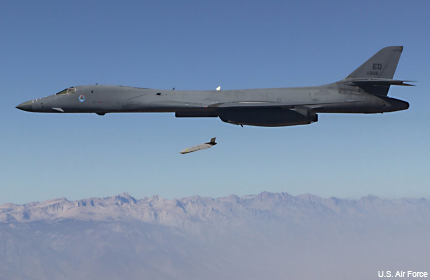New anti-ship missile conducts precision strikes without GPS
The Navy's LRASM, developed with DARPA and the Air Force, also reduced reliance on traditional — and jammable — ISR platforms and networking links.

LRASM is dropped from the belly of a B-1B bomber during tests.
The Navy’s newest anti-ship missile extends the range of the service’s arsenal while cutting down reliance on traditional guides such GPS signals, ISR (intelligence, surveillance and reconnaissance) platforms and network links.
The Long Range Anti-Ship Missile (LRASM), developed under a Defense Advanced Research Projects Agency program in cooperation with the Navy and the Air Force, successfully completed its third and most recent test Feb. 4 at Sea Test Range in Point Mugu, Calif. After being dropped from a B-1B bomber, the prototype missile his preset waypoints and avoided an obstacle on its way to the target, according to an announcement from DARPA.
LRASM, which became a Navy program of record a year ago after two successful tests in 2013, would seem to help solve a couple of problems for the Navy.
One: Its strike range is getting smaller as its existing planes and missile get older, while at the same time enemies’ stroke range is growing. LRASM could help counter that, retaining the Navy’s ability to fire while outside of an enemy’s reach.
Two: It helps counter concerns about the military’s overreliance on GPS, which can be jammed or spoofed, as well as ISR platforms and network connectivity, which can be disrupted through the electromagnetic spectrum. Developing alternation location and navigation tools a shared focus of both the Defense Department’s updated electromagnetic warfare policy, released in April 2014, and the just-released instruction on Positioning, Navigation, and Timing, and Navigation Warfare, which particularly concerns GPS.
LRASM consists of the semi-autonomous Joint Air to Surface Standoff Missile Extended Range airframe, along with sensors and systems designed to make it a stealthy subsonic cruise missile, capable of operating in areas where traditional electronic or satellite access is disrupted or denied. Among its other technologies are anti-obstacle algorithms that enabled it to avoid the object placed in its path during the recent test. Its integrated sensor suite includes the ability to sense and fuze targets and validate the geolocation algorithms.
Lockheed Martin is the lead contractor for demonstration of the LRASM system; BAE Systems is designing and building the sensor systems.
Started in 2009, the LRASM program started with two versions: the subsonic, low-altitude LRASM-A; and LRAS-B, which would operate at high altitudes and supersonic speeds. Eventually, officials decided to focus, for now at least, only on the LRASM-A and put the riskier LRASM-B on hold.
While the current prototype is designed for air-to-ship (or in the case of the Air Force, air-to-ground) missions, the program could expand to include surface-to-air and ship-to-air capabilities.
A five-year stretch from start to program of record is pretty fast for a complex weapons system, and DARPA said it reflects the value of another DOD program, Better Buying Power 3.0, which seeks to speed up development, boost innovation and cut costs with techniques such as rapid prototyping.
“We’ve shown that by taking advantage of the Defense Department’s evolving acquisition policy, it is possible to significantly accelerate the fielding of a high-payoff technical system for the warfighter,” said Artie Mabbett, director of the joint-service LRASM Program Office.
NEXT STORY: Can a handheld device detect IEDs?



